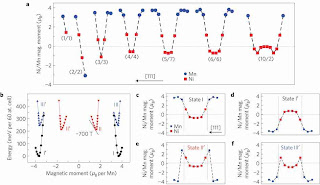Marius V. Costache, German Bridoux, Ingmar Neumann, and Sergio O. Valenzuela
Nature Mater. 11, 199 (2012)
 |
| Magnon-drag detection principle and geometry of the device. |
A blog dedicated to recent publications in the field of Nanomagnetism. A selection of links to articles in the most important topics of magnetism of nanoparticles and nanostructures will appear here in a regular basis. Comments and discussion about the results will be welcome.
 |
| Magnon-drag detection principle and geometry of the device. |
 |
| LLB-I equation |
 |
| LLB-II equation |
 |
| Magnetic loops and temperature dependence of exchange bias field. |
 |
| Results of the first-principles calculations. |
 |
| (a) The nonadiabaticity parameter β and (b) the nonadiabaticity parameter γ as a function of the exchange parameter J , calculated for indicated values of η. |
 |
| Spin-wave absorption spectra (a) and mode structure [(b) and (c)] in a magnetic dot array in a FM ground state having one defect per 11 × 11 dots. |
 |
| Add caption |
 |
| The unit cell of CuO and the two neighboring Cu-O layers in the ac planes. The light and dark gray balls represent oxygen and copper atoms, respectively. Top right: The clusters used in this wor |
 |
| Simulated magnetization loops of R¯3 systems with (a) 100%, (b) 75%, and (c) 50% FM bonds. Squares correspond to systems with composition x = 1.0, circles to 0.8, and diamonds to 0.6 |
 |
| Temperature dependences of the coercive (upward triangles) and EB fields (downward triangles) of each of the F layers in the trilayer stack: (a) [Pt/Co]8 and (b) Co3Pt. |
 |
| Mössbauer spectra of 8-nm α-Fe2O3 nanoparticles obtained at the indicated temperatures; (a) ferrofluid sample, (b) powder sample, and (c) mixed with NiO nanoparticles |

 |
| Minimal configurations for rectangular samples of different shapes. |
 |
| Critical temperature as a function of the nanotube diameter for SMNTs and HMNTs. |